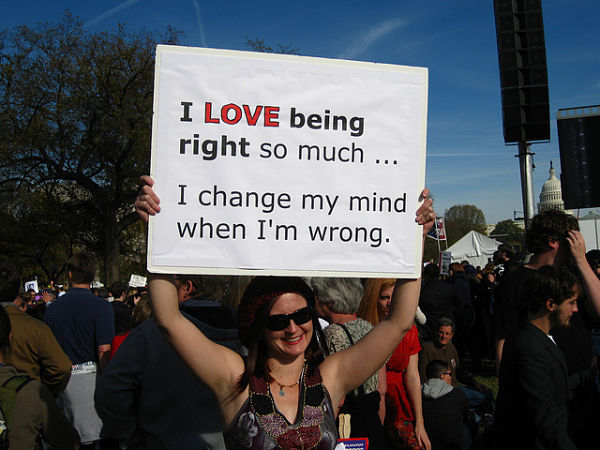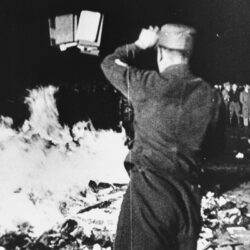 Public Policy
Public Policy A Political Scientist Asks Why Did We Get US Election So Wrong?

Timely advice for our pollsters and political scientists? (Photo: Sadat Shaml/Flickr/CC BY 2.0)
Two days before Election Day, I presented my predictions for the outcome of the US presidency. I was wrong. But I’m in very good company.
Almost every pollster, pundit and political scientist in the world got it wrong, too. Indeed, Politico Magazine called Donald Trump’s victory “the biggest upset in American history.”

This article by Bryan Cranston originally appeared at ” target=”_blank”>The Conversation, a Social Science Space partner site, under the title “How did we get the result of the US Election so wrong?”
I predicted Hillary Clinton to win 347 votes in the Electoral College. Larry Sabato, director of the Center for Politics at the University of Virginia (and arguably the foremost expert in American elections) predicted Clinton to win 322 Electoral College votes. Even Nate Silver (from FiveThirtyEight and The New York Times) who in 2012 accurately predicted the election result in every US state, said the day before the election Clinton had a 70.6 percent chance at winning.
The modeling
Sabato and Silver base their forecasts on average results of public polling. I have long argued that we should ignore public polls, as they’re increasingly proving to be wrong. Yesterday’s result added further validity to that argument.
I arrived at my forecast based on a different type of modeling. I do not look at opinion polls; rather, I look at historical election results as a predictor of what might happen next.
By looking at the last six presidential elections since 1992, we made what we thought were reasonable assumptions about how particular states might vote. By looking at which states had voted for the Democratic Party in every one of those six elections, Clinton should have won a minimum of 242 Electoral College votes. Trump should have won a minimum of 180 votes.
By factoring in states that each party always won, added to those they won most of the time (“likely states”), the forecast result was Clinton 257 vs Trump 206 – with 75 votes up for grabs among the “swing” states. Provided Clinton won all the states she was expected to, she did not need to win either Florida or Ohio. On the other hand, Trump needed to win both.
Clinton ended up with the worst election result by a Democratic candidate since Michael Dukakis in 1988, losing states such as Michigan, Pennsylvania, and Wisconsin, which the Democrats had not lost in a generation.
What did I get right?
Prior to the election, I said that if the Republicans held Virginia’s 10th Congressional District, then the Democrats would gain only 10-12 seats in the House of Representatives. With voting still underway in many seats, the Democrats have won nine seats, with a net gain of six.
I also forecast that the Republicans would win a number of gubernatorial elections, specifically that they would end Election Day with with 33 governors, which is exactly what they won.
And, despite many pundits suggesting the Democrats would regain control of the Senate, I forecast the Republicans to win 51 seats to the Democrats’ 49. The result will be (after the Louisiana run-off election) that the Republicans will retain control, 52-48.
Why were so many of us wrong?
The biggest factor in the election punditry was the universal failure to recognize the level of disenchantment among white voters. The United States has long had social divisions based on race and ethnicity, but many of us believed the nation was moving beyond those issues. This year’s Black Lives Matter campaign should have served as a reminder.
The fact is that white voters rallied to Trump in numbers the Republican Party has not seen in quite some time. Trump received the support of approximately 14% more white voters than Mitt Romney in 2012.
Before the election, an ABC News/Washington Post poll found that 37 percent of Trump’s supporters strongly believed that white Americans were being economically disadvantaged due to a perceived preference for Hispanics and African Americans.
In June 2016, a study conducted by the University of California and Stanford University found that many white Americans were more likely to support Trump when they were reminded that according to US Census Bureau data, non-white ethnic groups will comprise the majority of the US population by 2044. The proof was in the exit poll pudding. According to The New York Times, 64 percent of voters said that immigration was their main concern.
The National Socialist Movement, various factions of the Ku Klux Klan and the white nationalist American Freedom Party are ardent supporters of Trump. Last week, a US federal judge announced a judicial hearing into claims that the Trump campaign had violated the Voting Rights Act of 1965 and the Ku Klux Klan Act of 1871 in Nevada, Arizona, Ohio and Pennsylvania.
Today, a former KKK leader congratulated Trump on his win, saying it was a “great victory for our people.”
Why did Trump’s campaign resonate with so many people?
Clinton ran a “safe” campaign, relying on the assumption she would win states the Democrats always did.
This election campaign has done more than elect Trump. It has shown that voters are no longer interested in facts or logic when it comes to exercising their democratic right.
PolitiFact identified Trump as lying 70 percent of the time, compared with Hilary Clinton lying 26 percent of the time. Yet Clinton was viewed as the more untrustworthy candidate. Unfortunately, a disregard for intellectualism now appears to be considered a good thing.
I was wrong because I based my forecasts on historical results, and didn’t take into account the true impact of America’s racial and ethnic divide. This is the biggest issue facing the country today. President-elect Trump, who ran a campaign based on generating fear about and anger against migrants and non-white ethnic groups must now attempt to heal a massively divided nation.
As former British Prime Minister Winston Churchill is purported to have said: the best argument against democracy is five minutes with the average voter.
I wonder how many are pondering that today?![]()
























































































